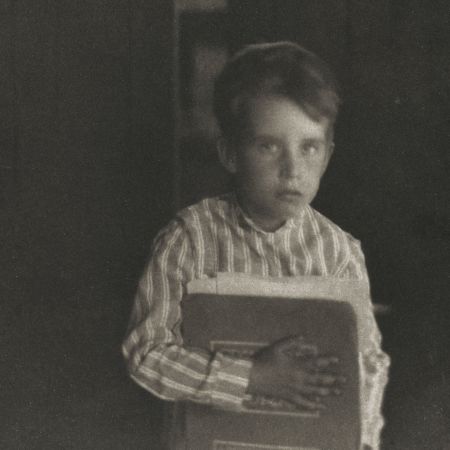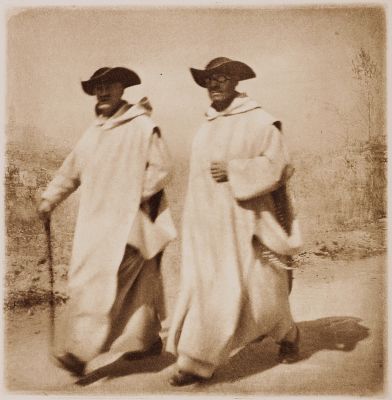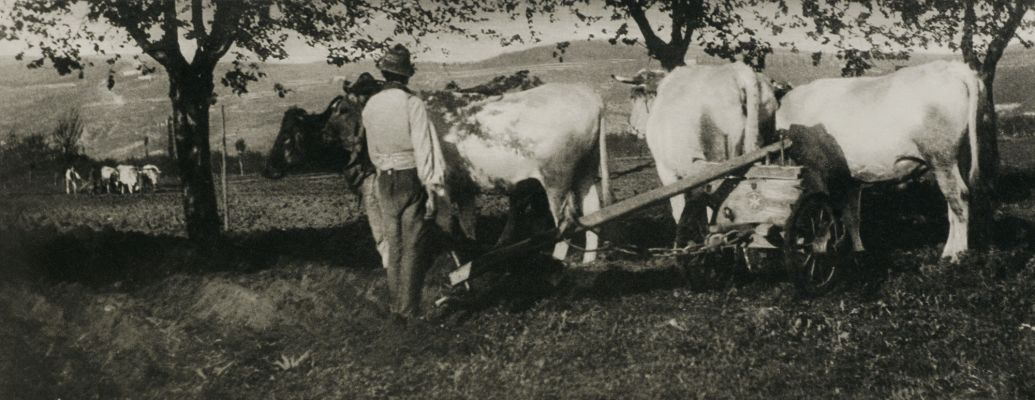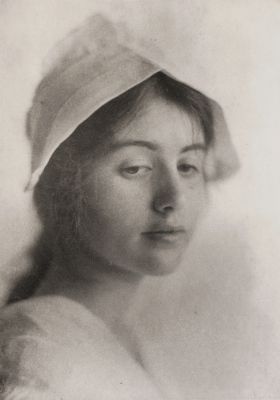
Title
Janet BurnetArtist
Annan, James Craig (Scottish, 1864-1946)Key FigurePublication
Camera Notes Vol. 4 No. 3Date
1901Process
PhotogravureAtelier
James Craig AnnanImage Size
12 x 14.5 cm
One of Annan’s most famous early photographs was inspired by Whistler and Hill and Adamson. Annan himself made the photogravures of his that appeared in many Journals including Camera Notes and Camera Work.
In old age he rarely fails, and his portrait of Miss Burnet is a masterpiece, and one of the finest things in photography since the days and works of D. O. Hill, R. S. A., the Scottish painter who when photography was young did work never since excelled, and others have never equaled. [1] Influenced by Whistler’s Mother and Hill and Adamson’s Mrs. Rigby, Annan kept a print of this image on his mantle. He said of it, “there’s no sweeter presentment of old age”. [2]
Miss Burnet is truly characteristic. She has an impeccable mask of profound and engaging beauty. You would swear the work was done by the paint brush of a 16th century Master. The pose is natural and simple; there is fine movement of lines; an expression full of character with some touches and highlights done with a perfect knowledge of the anatomy of the face, giving an extraordinary relief and intensity of life. The placing on the page gives it a style and a grandeur which compels admiration. [3]
The photograph of Miss Burnet is an excellent achievement. It was the most perfect portrait both at the Munich exhibition and now in Berlin. The black-brown print looks elegant and superior in its matt black frame. The effect of the picture has been heightened and a balance between lightness and dark was created by drawing the title on the dark area. From a distance it appears as a light mark thus giving the whole picture a rare feeling of completeness. There is also the delightful modulation of the head, the delicate, hardly visible lack of definition and the wonderful interpretation. It seems to us that this is the best portrait we have ever seen in photography. [4]
Miss Burnet. – a portrait taken in an ordinary room with low windows and the light immediately behind the camera. In brief, the artist has flown in the face of traditional teaching. But the splendid result more than justifies such rank heresy. We have an example – as interesting as it is exceptional – of a photograph which at the time of its exhibition (1894) instantly compelled admiration and is still as widely esteemed today. The reason being probably its natural and unconventional character. Everyone at once says, ‘What a charming picture! I am sure it must be a good likeness.’ We shall not fail to note the boldness in putting the title just where it is – a craftsman’s touch which perhaps owes some of its success to its daring nature. [5]
Reproduced / Exhibited
Buchanan, William. J. Craig Annan: Selected Texts and Bibliography. Oxford: Clio Press, 1994. fig. 15.
Haworth-Booth, Mark. The Golden Age of British Photography, 1839-1900: Photographs from the Victoria and Albert Museum, London [and Others]. New York: Aperture, 1984 172
Kruse, Margret. Kunstphotographie Um 1900: D. Sammlung Ernst Juhl; Hamburg: Museum für Kunst u. Gewerbe, 1989 pl. 22
Simpson, Roddy. The Photography of Victorian Scotland. Edinburgh: Edinburgh University Press, 2013. p. 169
References
[1] Buchanan, William. J. Craig Annan: Selected Texts and Bibliography. Oxford: Clio Press, 1994.
[2] ibid
[3] Abridged from Bibl. 84: Edmond Sacre. ‘Exposition des Oeuvres de Craig Annan de Glasgow’ (‘Exhibition of Work by Craig Annan of Glasgow’). Bulletin de VAssociation Beige de Photographic vol. 24, no. 6 (June 1897), p. 405-17. Translation from French.
[4] Translation from German. Bibl. 108: ‘M’ [F. Matthies-Masuren]. ‘J. Craig Annan Glasgow’. Photographisches Centralblatt, 5th Year, no. 4 (5 Feb. 1899), p. 81-85.(Buchanan)
[5] Extract from Bibl. 153: The Editor [F. C. Lambert]. The Pictorial Work of J. Craig Annan’. The Practical Photographer, Library Series, no. 13, (1904), p. 1-5. Buchannan P 115




